 |
|
|||
 |
 |
|||
RINKER ON COLLECTIBLES — Column #1767 Copyright © Harry Rinker, LLC 2020 Questions
and Answers
QUESTION: I have a 1960s vintage Lloyd’s stereo unit that features a turntable and AM/FM radio and a set of two detached speakers. I need to find a needle for the tone arm of the turntable. I would like to know its estimated value. – JC, Hatboro, PA, Email Question 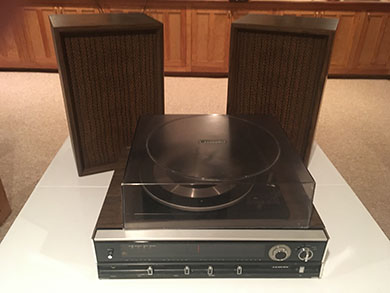
ANSWER: Lloyd’s Electronics, located in Chicago, was a distributor of low-end (budget) radios, stereo combos, and tape players, some with built in 8-track players and turntables, during the 1960s and 1970s. As one person posted on the forum of Antique Radios in July 2011: “So I was at Goodwill today, and I saw my first console since I started going back here last year. This was one of the cheapest solid-state jobs I have ever seen. It was obviously pressed particle board. It had an 8-track player, the cheapest, literally no-name changer that I had ever seen and a radio. The whole thing screamed low-end, bottom of the market. Everything but the radio was marked “Taiwan” and that had a tiny little Lloyd’s nameplate.” North American Rockwell Corporation had a consumer electronic subsidiary called Lloyd’s Electronics. It sold a wide range of models of its Accumatic calculator. Rockwell made some. Most were made in Asia. Based upon existing product catalogs and manuals, Lloyd’s Electronics had two warehouse locations – 180 Raritan Center Parkway in Edison, New Jersey and 1220 Kona Drive in Compton, California. Lloyd’s did market an up-scale line of hi-fi and stereo equipment and components under the “Monteverdi” and “Monteverdi Audio” brands from the late 1970s through the 1980s. The Edison warehouse held several warehouse sales in the 1990s at which Lloyd products were sold at a fraction of their normal selling prices. Most were overstocked items, returned/repaired products, and discontinued products. Lloyd’s Electronics products are associated with K-Mart, Fingerhut, and other discount outlets. I had a chance to discuss your Lloyd’s Electronic stereo with Doug Herrenden, host of the “11th Hour” show on WRTA in Altoona, Pennsylvania. He remembers seeing Lloyd’s Electronics equipment at local discount chain stores in his area. [Author’s Aside: I do a special live WHATCHA GOT? edition once a month (usually on the third Monday at 11:00 AM) on WRTA that is hosted by Doug. The show streams live on the internet and is archived on WRTA and www.harryrinker.com. Calls about antiques and collectibles are welcome.] Lloyd’s Electronics phonograph and radio combination stereo units appear regularly on internet sale sites. Asking prices range from $65.00 to $150.00. Asking is not getting. WorthPoint.com sell though data suggest $60.00 is a top price. A more realistic price for your Lloyd’s Electronics stereo with turntable and AM/FM radio and two speakers is between $25.00 and $35.00. A needle for your tone arm is readily available on the internet. You may have to search a little but you should have no trouble finding one. QUESTION: My friend has a desk that she believes dates back to the late 18th or early 19th century. It consists of a base with long tapered circular Queen Anne legs ending in padded feet on the front and square tapered legs in the back. The top of the base contains a horizontal drawer flanked on each side by a pull upon which rest the foldout front quarter of the top. A unit consisting of two sets of four vertical drawers separated by two solid prospect doors rests on the back half of the top. “NO-5780 DESK / CANDLELIGHT PLY” is stenciled on the back of the top. “PENNSYLVANIA/ HOUSE” in an oval is branded inside the front left corner of the large horizontal drawer in the base frame. There also is a paper tag containing a “Guaranteed by Good Housekeeping” logo and “PENNSYLVANIA HOUSE / FURNITURE / LEWISBURG / PENNSYLVANIA.” What exactly does my friend have and what is it worth? – TK, Emmaus, PA, Email Question 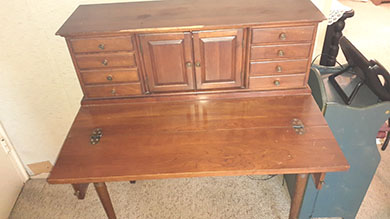
ANSWER: Your friend owns a copycat (stylistic copy), mid-20th century Colonial Revival country-style desk that contains a mix of historical design styles – Queen Anne, Chippendale, and Federal. In the mid-20th century, Pennsylvania House was a household name in the American furniture business. Its cherry, maple, and oak furniture, most of which was in Colonial Revival styles, was found in living rooms, dining rooms, and bedrooms of homes across the country. Pennsylvania House was founded in 1887. For much of its early years, all its lumber came from a 100-mile radius of Lewisburg, nicknamed the “Cherry Capital of the World.” The old growth cherry trees provided cherry wood through the 1970s. Pennsylvania House’s cherry furniture was extremely popular with middle- and upper-class families from the 1930s through the early 1960s. By the 1990s and 2000s, Pennsylvania House struggled to compete with cheap foreign furniture imports, primarily from China and Mexico. Solid wood furniture became a luxury item. Today, few furniture retailers carry the line. Starting in 2005, the name brand was bought and sold numerous times by larger corporations among whom were La-Z Boy (2005) and Universal Furniture (2007). La-Z Boy moved Pennsylvania House production overseas, causing the loss of 450 jobs in the Lewisburg area. Pennsylvania House furniture’s secondary market value is “reuse.” No one collects it. Those who buy it do so because it has a high manufacturing quality, is made of solid wood, and is an old middle market brand that some remember. A realistic secondary “reuse” value for your friend’s desk is between $250.00 and $350.00. Modern copies cost three to four times this. STUMPER: It is not often that I am stumped. The following question is one of them. I own a pair of lantern-style lamps, one with a figure of a Victorian lady and child and the other with a Victorian gentleman and child. Each lamp is supplemented with an elaborate ribbon and floral display at the top of the post standard and at the base. They are hand signed on the bottom: “The Victorian Caroller / Lamp Posts / © 1975 by Monica & Ron / Thomas” beneath which is a label reading: “An Original Design / © Copyright 1990-1992-1993 / By Monica & Ron Thomas / The Mascot Company.” I was wondering if you know of any information about them or their value. – MC, Lindenhurst, IL 60046 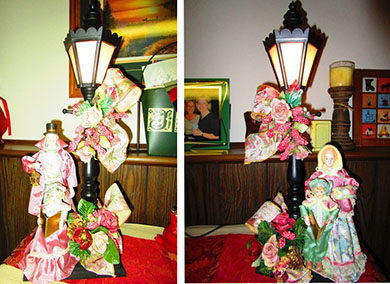
ANSWER: I have revisited this question several times since its arrival. I cannot find anything about these lamps. I am not accustomed to failure. The lamps clearly are not one-of-a-kind. Monica and Ron Thomas made them for several years. When I first saw them, I immediately thought home shopping channel merchandise. If true, they should have showed up on the secondary market on multiple internet sites. Readers, I need your help. If you can provide any insight into Monica & Ron Thomas and the Mascot Company, email the information to me at harrylrinker@aol.com. Curious minds want to know, especially mine. QUESTION: My parents were married in December 1912. At some point, they purchased an Edison Disc Phonograph Model BC-34. The phonograph sits above an internal speaker hidden behind fretwork and a cloth screen. Record storage areas behind closed cupboard doors flank each side of the central unit. The last patent number on the serial plate is “May 23, 1916.” I have over 30 Edison and Pathé records. Although the case is in rough condition, it still plays. In addition, I have a can of Edison Grease and a can of Edison oil. The good news is that my 25-year old grandson wants the record player. Before passing it on to him, I would like to know its value. – BF, Indianapolis, IN, Mail Question 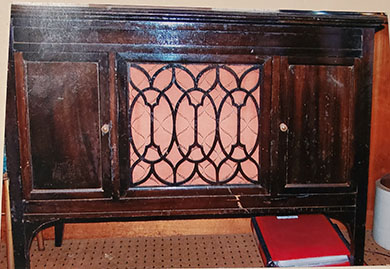
ANSWER: Your Model BC-34 Edison Diamond Disc Phonograph is in a Hepplewhite-style case. The BC-34 was a popular model. Based on the listings for examples that I found on the Internet, the BC-34 appears to have been introduced in the early 1920s. Several listings provide 1922 as the date. The mere fact your grandson wants the phonograph makes it priceless in respect to family value. In terms of secondary market value given the condition of the case, neither the case or mechanism has been restored, and it still works, a fair market value is between $50.00 and $65.00. Restored examples currently are selling through in the $100.00 to $150.00 range. The Edison Grease and Edison oil containers have a value between $12.00 and $15.00 each. 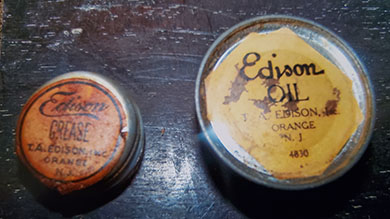
Harry L. Rinker welcomes questions from readers about
collectibles, those mass-produced items from the twentieth and twenty-first centuries.
Selected letters will be answered in this column.
Harry cannot provide personal answers.
Photos and other material submitted cannot be
returned.
Send your questions to: Rinker on Collectibles, 5955 Mill
Point Court SE, Kentwood, MI 49512.
You also can e-mail your questions to
harrylrinker@aol.com.
Only e-mails containing a full name and mailing address
will be considered.
|
||||